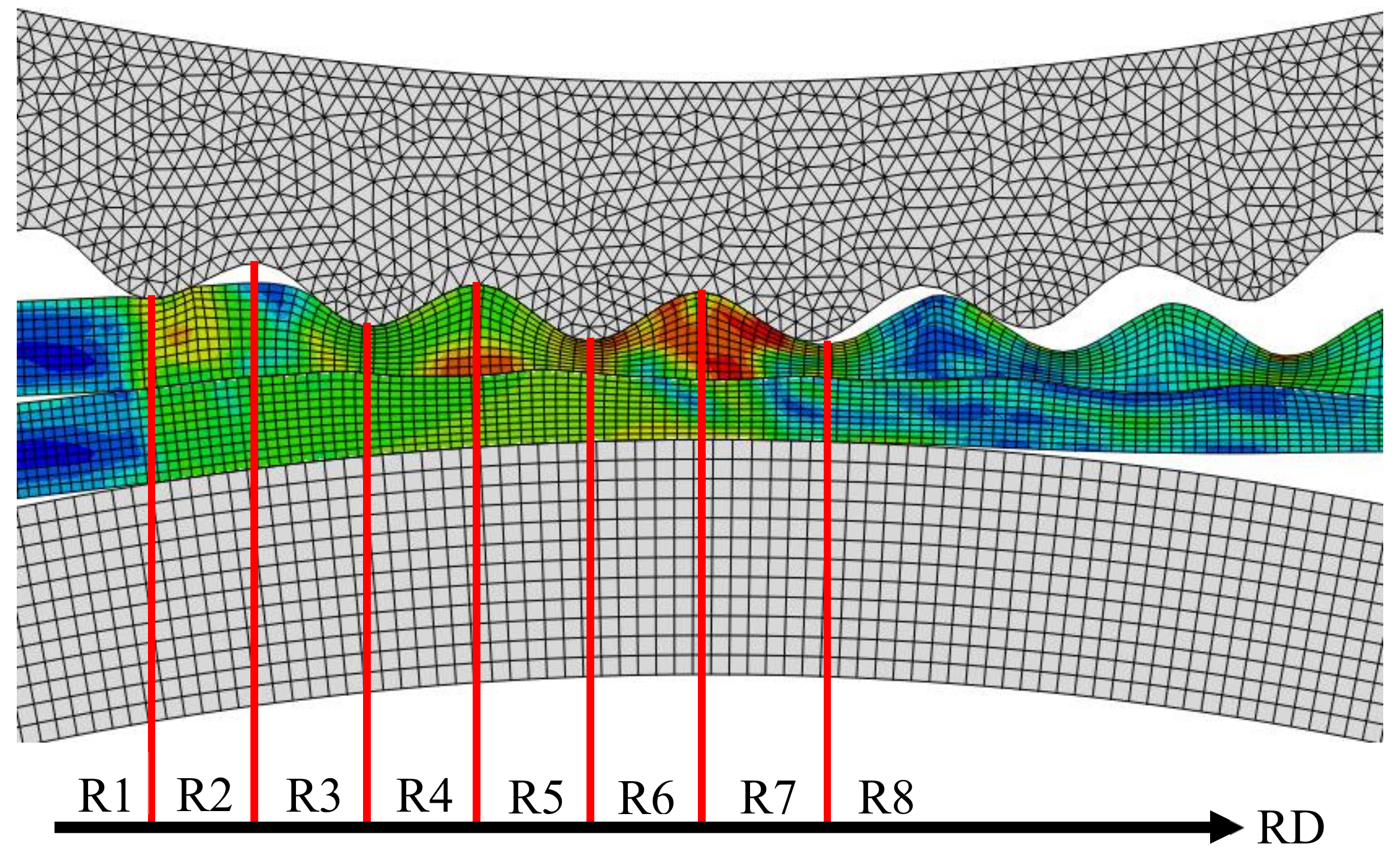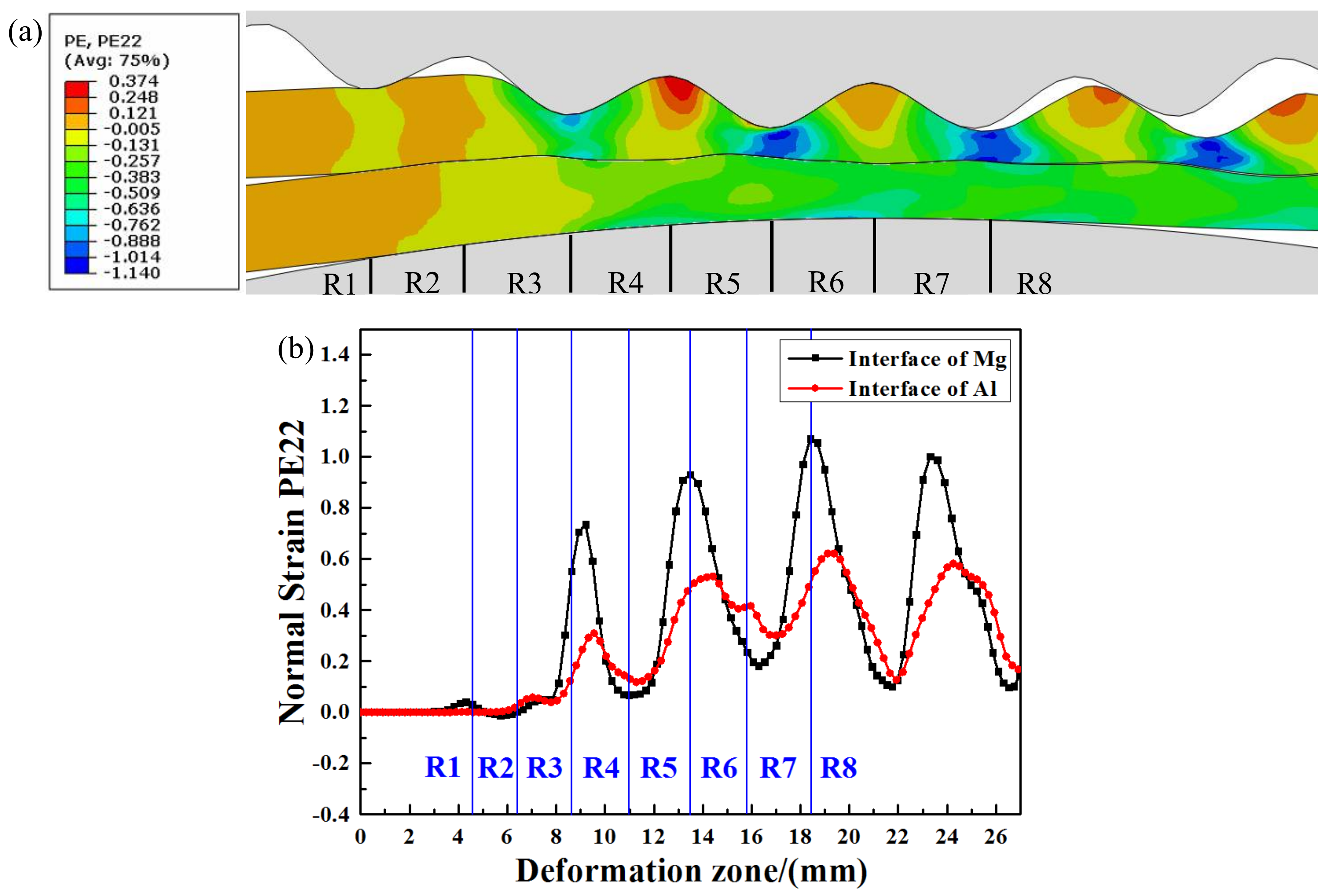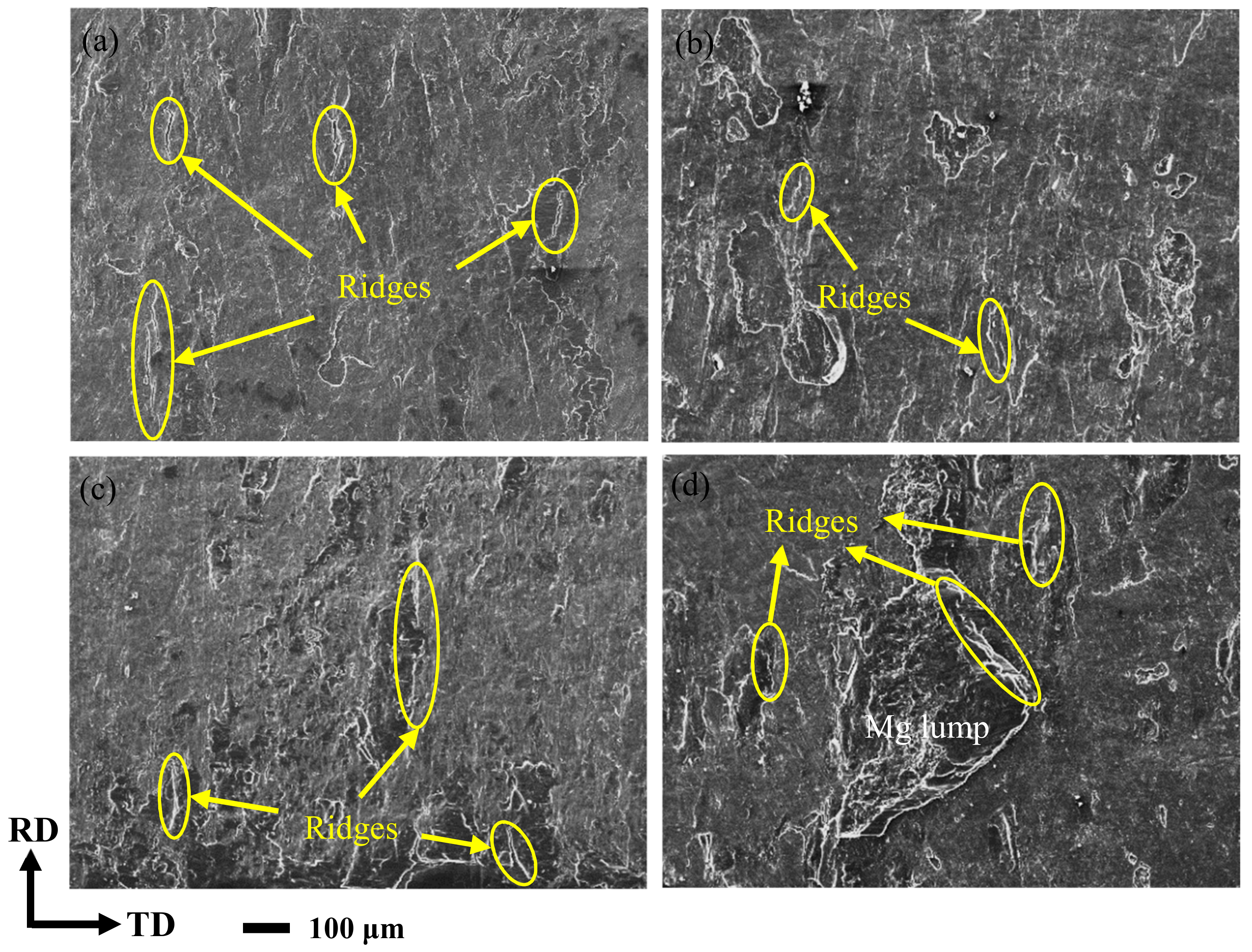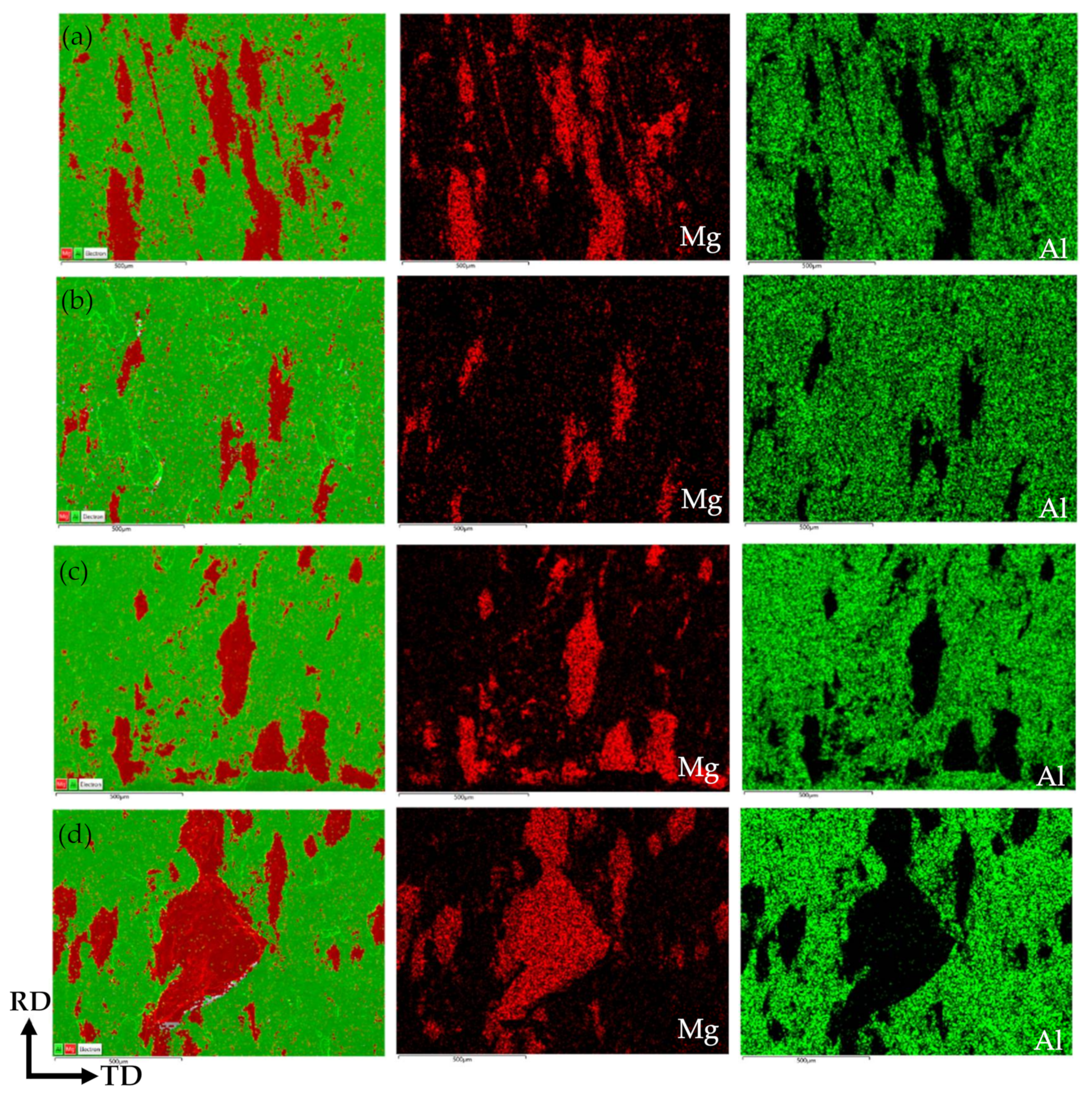Interface Characteristics and Bonding Performance of the Corrugated Mg/Al Clad Plate
Abstract
:1. Introduction
2. Experimental Method and Numerical Simulation
2.1. Experimental Method
2.2. Numerical Simulation
3. Results and Discussion
3.1. Interface Morphology of the Corrugated Mg/Al Clad Plate
3.2. Effect of Stress and Strain on Interface Metal Deformation
3.3. Research of the Cross-Shear Zone
3.4. Tensile-Shear Property
4. Conclusions
Author Contributions
Funding
Institutional Review Board Statement
Informed Consent Statement
Data Availability Statement
Conflicts of Interest
References
- Wasekar, N.P.; Latha, S.M.; Ramakrishna, M.; Rao, D.S.; Sundararajan, G. Pulsed electrodeposition and mechanical properties of Ni-W/SiC nano-composite coatings. Mater. Des. 2016, 112, 140–150. [Google Scholar] [CrossRef]
- Chen, L.; Fu, Y.; Yin, F.; Liu, N.; Liang, C. Microstructure and Mechanical Properties of Mg/Al Clad Bars with Ni Interlayer Processed by Compound Castings and Multi-Pass Caliber Rolling. Metals 2018, 8, 704. [Google Scholar] [CrossRef] [Green Version]
- Ahledel, N.; Schulz, R.; Gariepy, M.; Hermawan, H.; Alamdari, H. Electrochemical Corrosion Behavior of Fe3Al/TiC and Fe3Al-Cr/TiC Coatings Prepared by HVOF in NaCl Solution. Metals 2019, 9, 437. [Google Scholar] [CrossRef] [Green Version]
- Tang, J.; Chen, L.; Zhao, G.; Zhang, C.; Yu, J. Study on Al/Mg/Al sheet fabricated by combination of porthole die co-extrusion and subsequent hot rolling. J. Alloy. Compd. 2019, 784, 727–738. [Google Scholar] [CrossRef]
- Wachowski, M.; Kosturek, R.; Sniezek, L.; Mroz, S.; Stefanik, A.; Szota, P. The Effect of Post-Weld Hot-Rolling on the Properties of Explosively Welded Mg/Al/Ti Multilayer Composite. Materials 2020, 13, 1930. [Google Scholar] [CrossRef] [Green Version]
- Qi, Z.C.; Yu, C.; Xiao, H. Microstructure and bonding properties of magnesium alloy AZ31/CP-Ti clad plates fabricated by rolling bonding. J. Manuf. Process. 2018, 32, 175–186. [Google Scholar] [CrossRef]
- Nemcko, M.J.; Qiao, H.; Wu, P.D.; Wilkinson, D.S. Effects of void fraction on void growth and linkage in commercially pure magnesium. Acta. Mater. 2016, 113, 68–80. [Google Scholar] [CrossRef]
- Yang, M.; Liu, X.B.; Zhang, Z.Y.; Song, Y.L. Stress Corrosion Behavior of AM50Gd Magnesium Alloy in Different Environments. Metals 2019, 9, 616. [Google Scholar] [CrossRef] [Green Version]
- Liu, X.W.; Sun, J.K.; Zhou, F.Y.; Yang, Y.H.; Chang, R.C.; Qiu, K.J.; Pu, Z.J.; Li, L.; Zheng, Y.F. Micro-alloying with Mn in Zn–Mg alloy for future biodegradable metals application. Mater. Des. 2016, 94, 95–104. [Google Scholar] [CrossRef]
- Jiang, M.G.; Yan, H.; Chen, R.S. Microstructure, texture and mechanical properties in an as-cast AZ61 Mg alloy during multi-directional impact forging and subsequent heat treatment. Mater. Des. 2015, 87, 891–900. [Google Scholar] [CrossRef]
- Yan, Z.; Wang, D.; Wang, W.; Zhou, J.; He, X.; Dong, P.; Zhang, H.; Sun, L. Ratcheting Strain and Microstructure Evolution of AZ31B Magnesium Alloy under a Tensile-Tensile Cyclic Loading. Materials 2018, 11, 513. [Google Scholar] [CrossRef] [PubMed] [Green Version]
- Mishra, R.R.; Sharma, A.K. On mechanism of in-situ microwave casting of aluminium alloy 7039 and cast microstructure. Mater. Des. 2016, 112, 97–106. [Google Scholar] [CrossRef]
- Simar, A.; Bréchet, Y.; de Meester, B.; Denquin, A.; Gallais, C.; Pardoen, T. Integrated modeling of friction stir welding of 6xxx series Al alloys: Process, microstructure and properties. Prog. Mater. Sci. 2012, 57, 95–183. [Google Scholar] [CrossRef] [Green Version]
- Nie, H.H.; Liang, W.; Chen, H.S.; Zheng, L.W.; Chi, C.Z.; Li, X.R. Effect of annealing on the microstructures and mechanical properties of Al/Mg/Al laminates. Mater. Sci. Eng. 2018, 732, 6–13. [Google Scholar] [CrossRef]
- Zhang, N.; Wang, W.X.; Cao, X.Q.; Wu, J.Q. The effect of annealing on the interface microstructure and mechanical characteristics of AZ31B/AA6061 composite plates fabricated by explosive welding. Mater. Des. 2015, 65, 1100–1109. [Google Scholar] [CrossRef]
- Luo, C.Z.; Liang, W.; Chen, Z.Q.; Zhang, J.J.; Chi, C.Z.; Yang, F.Q. Effect of high temperature annealing and subsequent hot rolling on microstructural evolution at the bond-interface of Al/Mg/Al alloy laminated composites. Mater. Charact. 2013, 84, 34–40. [Google Scholar] [CrossRef]
- Chen, Z.Q.; Wang, D.Y.; Cao, X.Q.; Yang, W.W.; Wang, W.X. Influence of multi-pass rolling and subsequent annealing on the interface microstructure and mechanical properties of the explosive welding Mg/Al composite plates. Mater. Sci. Eng. 2018, 723, 97–108. [Google Scholar] [CrossRef]
- Wu, K.; Chang, H.; Maawad, E.; Gan, W.M.; Brokmeier, H.G.; Zheng, M.Y. Microstructure and mechanical properties of the Mg/Al laminated composite fabricated by accumulative roll bonding (ARB). Mater. Sci. Eng. 2010, 527, 3073–3078. [Google Scholar] [CrossRef]
- Wang, T.; Wang, Y.; Bian, L.; Huang, Q. Microstructural evolution and mechanical behavior of Mg/Al laminated composite sheet by novel corrugated rolling and flat rolling. Mater. Sci. Eng. 2019, 765, 138318. [Google Scholar] [CrossRef]
- Li, S.; Luo, C.; Bashir, M.-U.; Jia, Y.; Han, J.-C.; Wang, T. Interface structures and mechanical properties of corrugated + flat rolled and traditional rolled Mg/Al clad plates. Rare Met. 2021, 40, 2947–2955. [Google Scholar] [CrossRef]
- Wang, T.; Li, S.; Niu, H.; Luo, C.; Ma, X.; Liu, Y.; Han, J.; Bashir, M.U. EBSD research on the interfacial microstructure of the corrugated Mg/Al laminated material. J. Mater. Res. Technol. 2020, 9, 5840–5847. [Google Scholar] [CrossRef]
- Wang, H.; Su, L.H.; Yu, H.L.; Lu, C.; Tieu, A.K.; Liu, Y.; Zhang, J. A new finite element model for multi-cycle accumulative roll-bonding process and experiment verification. Mater. Sci. Eng. 2018, 726, 93–101. [Google Scholar] [CrossRef] [Green Version]
- Wang, T.; Li, S.; Ren, Z.; Han, J.; Huang, Q. A novel approach for preparing Cu/Al laminated composite based on corrugated roll. Mater. Lett. 2019, 234, 79–82. [Google Scholar] [CrossRef]
- Wang, T.; Li, S.; Ren, Z.; Jia, Y.; Fu, W.; Guo, M.; Ma, X.; Han, J. Microstructure Characterization and Mechanical Property of Mg/Al Laminated Composite Prepared by the Novel Approach: Corrugated + Flat Rolling (CFR). Metals 2019, 9, 690. [Google Scholar] [CrossRef] [Green Version]
- Wang, T.; Liu, W.; Liu, Y.; Wang, Z.; Ignatov, A.V.; Huang, Q. Formation mechanism of dynamic multi-neutral points and cross shear zones in corrugated rolling of Cu/Al laminated composite. J. Mater. Process. Tech. 2021, 295, 117157. [Google Scholar] [CrossRef]
- Xiao, H.; Qi, Z.; Yu, C.; Xu, C. Preparation and properties for Ti/Al clad plates generated by differential temperature rolling. J. Mater. Process. Tech. 2017, 249, 285–290. [Google Scholar] [CrossRef]
- Han, J.; Niu, H.; Li, S.; Ren, Z.; Jia, Y.; Wang, T.; Plokhikh, A.I.; Huang, Q. Effect of Mechanical Surface Treatment on the Bonding Mechanism and Properties of Cold-Rolled Cu/Al Clad Plate. Chin. J. Mech. Eng. 2020, 33, 69. [Google Scholar] [CrossRef]
- Eizadjou, M.; Danesh Manesh, H.; Janghorban, K. Mechanism of warm and cold roll bonding of aluminum alloy strips. Mater. Des. 2009, 30, 4156–4161. [Google Scholar] [CrossRef]
- Yousefi Mehr, V.; Toroghinejad, M.R.; Rezaeian, A. The effects of oxide film and annealing treatment on the bond strength of Al–Cu strips in cold roll bonding process. Mater. Des. 2014, 53, 174–181. [Google Scholar] [CrossRef]










| Materials | Mg | Cu | Ca | Mn | Si | Al | Zn | Cr | Fe |
|---|---|---|---|---|---|---|---|---|---|
| Mg plate | Rest | 0.01 | 0.04 | 0.8 | 0.07 | 3.2 | 1.2 | - | - |
| Al plate | 2.2–2.8 | 0.1 | - | 0.1 | 0.25 | Rest | 0.1 | 0.15–0.35 | 0.4 |
| Materials | Ultimate Tensile Strength (MPa) | Yield Strength (MPa) | Fracture Elongation (%) |
|---|---|---|---|
| Mg plate | 284 | 171 | 24 |
| Al plate | 217 | 135 | 18 |
| Front Waist | Peak | Back Waist | Trough | ||
|---|---|---|---|---|---|
| Mg plate | 3.205 μm | 2.803 μm | 3.121 μm | 3.597 μm | |
| Al plate | 3.985 μm | 3.157 μm | 3.386 μm | 4.430 μm | |
| Map Images | Mg (%) | Al (%) |
|---|---|---|
| (a)-Front waist | 22.46% | 77.54% |
| (b)-Peak | 8.29% | 91.71% |
| (c)-Back waist | 16.3% | 83.7% |
| (d)-Trough | 29.34% | 70.66% |
Publisher’s Note: MDPI stays neutral with regard to jurisdictional claims in published maps and institutional affiliations. |
© 2021 by the authors. Licensee MDPI, Basel, Switzerland. This article is an open access article distributed under the terms and conditions of the Creative Commons Attribution (CC BY) license (https://creativecommons.org/licenses/by/4.0/).
Share and Cite
Li, S.; Liu, X.; Jia, Y.; Han, J.; Wang, T. Interface Characteristics and Bonding Performance of the Corrugated Mg/Al Clad Plate. Materials 2021, 14, 4412. https://doi.org/10.3390/ma14164412
Li S, Liu X, Jia Y, Han J, Wang T. Interface Characteristics and Bonding Performance of the Corrugated Mg/Al Clad Plate. Materials. 2021; 14(16):4412. https://doi.org/10.3390/ma14164412
Chicago/Turabian StyleLi, Sha, Xinyang Liu, Yi Jia, Jianchao Han, and Tao Wang. 2021. "Interface Characteristics and Bonding Performance of the Corrugated Mg/Al Clad Plate" Materials 14, no. 16: 4412. https://doi.org/10.3390/ma14164412





